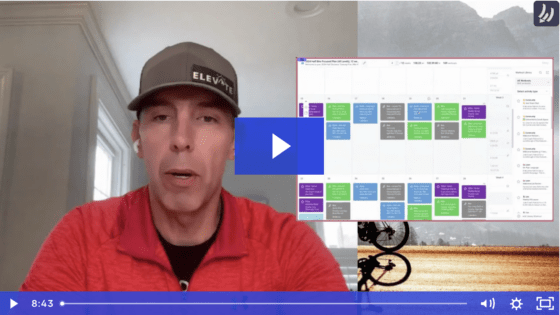
Author’s Note: This blog post is timely because many of the participants in our ENVEREST Challenge Series Need to make sure they are adequately recovering from significant early season training!
Most athletes struggle to find the time to actually train. Juggling many responsibilities such as work, family, social life, community responsibilities, make it hard to find a distinct priority. And being type A personalities ensures that athletes will try to be their best at ALL THE THINGS. Anything less is unacceptable.
But there’s an important myth about being your best that we need to address. The assumption that the harder you work the better the outcomes will be.
This message resonates with younger athlete and becomes ingrained in their athletic personality. As such, it’s hard for people to let go of. With years of working hard in your system, rewiring those expectations is only possible after some type of abject failure.
But as even professional athletes will tell you — you don’t have to fail in order to be successful.
Here’s a four-step protocol that we use with our athletes to make sure rest is integrated at a personal level into their training program and in their daily practice.
Step One: Exit Every Workout Intentionally
As we approach our workout we have a set goal in mind. Maybe it’s the main set. Maybe it’s a target power number. Perhaps it’s a certain number of repeats on your local hill. Whatever it is, success is predicated upon achieving that metric.
However, doing that work isn’t enough. In order to be able to process the work that we’ve done, we have to be ready to absorb it. The best way to absorb that workout is to make sure that our body is positioned optimally for recovery.
This begins at the end of every training session — the mandatory cool down. Those of you who finish your workout at the door and rush right to the next task are ultimately selling yourself short.
We recommend that you cool down for a minimum of 25% of your main set time up to 30 minutes.
If your main set is for 40 minutes, then you’ve got a 15-minute cool-down waiting for you. Do a mega weekend workout and you could have 22 1/2 minutes waiting for you.
This cooldown is effectively active recovery. Helping your muscles return to their natural state. Allowing your heart rate to come down allowing cortisol to decrease all of the systems need to wind down doing it in an active state is optimal.
Step Two: Get Rehydrated
Those of you with a limited schedule don’t have time to engage in deep recovery work. We can fast-track your recovery by making sure that you are well hydrated at the end of every training session. This may not be a factor during the weekday shorter workouts but absolutely starts to add up on the weekends.
The best way to make sure you’re staying on top of your nutrition is to make sure that you have a scale handy near where you get dressed for your training sessions. Weigh yourself before and after each training session in the same state — aka clothing (or not) — and capture just how much weight you’ve lost. Remember to add the fluids you consumed to the STARTING number you subtract from to get your true fluid losses. That weight loss is primarily fluid.
Over time you will learn what your baseline numbers are. Focus on returning to that number. In the short term, replace that lost fluid within the first 30 minutes of your workout. I recommend fluid replacement drinks that have electrolytes in them to facilitate the absorption.
Step Three: Get Elevated
This one is admittedly a little tricky. Not everyone has the opportunity to stay still after their workout. After all, there are so many things to do! Some of you will use compression, like our partners at Hyperice / Normatec make…learn the value in this podcast.
If possible, block off 15 minutes to elevate your legs. Ideally, this means laying down with your legs higher than your heart. The living room sofa is perfect for this, where you can lie down, head on a pillow, and your ankles/legs up on the other arm. Set a timer for 15 minutes and you are good to go.
We recommend you set a timer because experience has shown that often athletes will fall asleep after the hard work. Again this is a signal to your body that it’s time to move to recovery mode and is such a fantastic use of your time. You are not likely to fall asleep so this is a great opportunity to catch up on voicemails, emails, and other notifications.
Step Four: Be Scheduled
One of the easiest ways to make sure that you ruin any recovery you’ve done to this point is to botch the transition from working out to at work.
If possible, factor in extra time for your workout. If you’re going to exercise for an hour, plan for 90 minutes. This gives you 30 minutes of wiggle room to both shower and also recover.
If that’s not possible, you are not out of luck. You can strategically plan to have specific work after your workout session that is a better fit. It’s much easier to take phone calls as you exit workout mode than it is to sit down in a conference call meeting with a video camera on. It’s much easier to do research or reading after a workout than it is to go to a doctor’s appointment.
Conclusion
Take the time to strategically plan your post-workout work as best you can. The smoother we can make the transition from working out to being at work means the less additional stress you have on your system. Setting appropriate expectations at this time will help you be successful in both important focus areas. And the better you get at this, the more consistent you will be with your training and the less disrupted you’ll be at work. A total win-win!



Leave a Reply